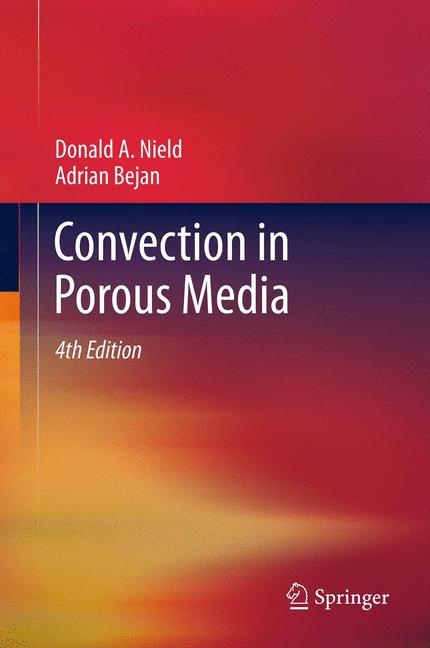
Convection in Porous Media
Springer-Verlag New York Inc.
9781461455400 (ISBN)
- Titel erscheint in neuer Auflage
- Artikel merken
Convection in Porous Media, 4th Edition, provides a user-friendly introduction to the subject, covering a wide range of topics, such as fibrous insulation, geological strata, and catalytic reactors. The presentation is self-contained, requiring only routine mathematics and the basic elements of fluid mechanics and heat transfer. The book will be of use not only to researchers and practicing engineers as a review and reference, but also to graduate students and others entering the field. The new edition features approximately 1,750 new references and covers current research in nanofluids, cellular porous materials, strong heterogeneity, pulsating flow, and more.
Preface to the Fourth Edition
Preface to the Third Edition
Preface to the Second Edition
Preface to the First Edition
Nomenclature
1 Mechanics of Fluid Flow through a Porous Medium
1.1 Introduction
1.2 Porosity
1.3 Seepage Velocity and the Equation of Continuity
1.4 Momentum Equation: Darcy's Law
1.4.1 Darcy's Law: Permeability
1.4.2 Deterministic Models Leading to Darcy's Law
1.4.3 Statistical Models Leading to Darcy's Law
1.5 Extensions of Darcy's Law
1.5.1 Acceleration and Other Inertial Effects
1.5.2 Quadratic Drag: Forchheimer's Equation
1.5.3 Brinkman's Equation
1.5.4 Non-Newtonian Fluid
1.6 Hydrodynamic Boundary Conditions
1.7 Effects of Porosity Variation
1.8 Turbulence in Porous Media
1.9 Fractured Media, Deformable Media, and Complex Porous Media
1.10 Bidisperse Porous Media
2 Heat Transfer through a Porous Medium
2.1 Energy Equation: Simple Case
2.2 Energy Equation: Extensions to More Complex Situations
2.2.1 Overall Thermal Conductivity of a Porous Medium
2.2.2 Effects of Pressure Changes, and Viscous Dissipation,
2.2.3 Absence of Local Thermal Equilibrium
2.2.4 Thermal Dispersion
2.2.5 Cellular Porous Media
2.3 Oberbeck-Boussinesq Approximation
2.4 Thermal Boundary Conditions
2.5 Hele-Shaw Analogy
2.6 Bioheat Transfer and Other Approaches
3 Mass Transfer in a Porous Medium: Multicomponent and Multiphase Flows
3.1 Multicomponent Flow: Basic Concepts
3.2 Mass Conservation in a Mixture
3.3 Combined Heat and Mass Transfer
3.4 Effects of a Chemical Reaction
3.5 Multiphase Flow
3.5.1 Conservation of Mass
3.5.2 Conservation of Momentum
3.5.3 Conservation of Energy
3.5.4 Summary: Relative Permeabilities
3.6 Unsaturated Porous Media
3.7 Electordiffusion through Porous media
3.8 Nanofluids
4 Forced Convection
4.1 Plane Wall with Prescribed Temperature
4.2 Plane Wall with Prescribed Heat Flux
4.3 Sphere and Cylinder: Boundary Layers
4.4 Point Source and Line Source: Thermal Wakes
4.5 Confined Flow
4.6 Transient Effects 4.6.1 Scale Analysis
4.6.2 Wall with Constant Temperature
4.6.3 Wall with Constant Heat Flux
4.6.4 Other Configurations
4.7 Effects of Inertia and Thermal Dispersion: External Flow
4.8 Effects of Boundary Friction and Porosity Variation: External Flow
4.9 Effects of Boundary Friction, Inertia, Porosity Variation, Viscous Dissipation, and Thermal Dispersion: Confined Flow
4.10 Local Thermal Nonequilibrium
4.11 Partly Porous Configurations
4.12 Transversely Heterogeneous Channels and Pipes
4.13 Thermal Development
4.14 Surfaces Covered with Porous Layers
4.15 Designed Porous Media
4.16 Other Configurations or Effects
4.16.1 Effect of Temperature-dependent Viscosity
4.16.2 Oscillatory Flows, Counterflows
4.16.3 Non-Newtonian Fluids
4.16.4 Bidisperse Porous Media
4.16.5 Other Flows, Other Effects4.17 Heatlines for Visualizing Convection
4.18 Constructal Tree Networks: Flow Access in Volume-to-Point Structures
4.18.1 The Fundamental Volume-to-Point Flow Problem
4.18.2 The Elemental Volume
4.18.3 The First Construct
4.18.4 Higher-Order Constructs
4.18.5 The Constructal Law of Design and Evolution in Nature
4.19 Constructal Multiscale Flow Structures; Vascular Design:
4.20 Optimal Spacings for Plates Separated by Porous Structures
5. External Natural Convection
5.1 Vertical Plate
5.1.1 Power Law Wall Temperature: Similarity Solution
5.1.2 Vertical Plate with Lateral Mass Flux
5.1.3 Transient Case: Integral Method
5.1.4 Effects of Ambient Thermal Stratification
5.1.5 Conjugate Boundary Layers
5.1.6 Higher-Order Boundary Layer Theory
5.1.7 Effects of Boundary Friction, Inertia, and Thermal Dispersion
5.1.7.1 Boundary Friction Effects
5.1.7.2 Inertial Effects
5.1.7.3 Thermal Dispersion Effects
5.1.8 Experimental Investigations
5.1.9 Further Extensions of the Theory
5.1.9.1 Particular Analytical Solutions
5.1.9.2 Non-Newtonian Fluids
5.1.9.3 Local Thermal NonEquilibrium
5.1.9.4 Volumetric Heating due to Viscous Dissipation, Radiation or Otherwise
5.1.9.5 Anisotropy and Heterogeneity
5.1.9.6 Wavy Surface
5.1.9.7 Time-dependent Gravity or Time-dependent Heating
5.1.9.8 Newtonian Thermal Boundary Condition
5.1.9.9 Other aspects
5.2 Horizontal Plate
5.3 Inclined Plate
5.4 Vortex Instability
5.5 Horizontal Cylinder
5.5.1 Flow at High Rayleigh Number
5.5.2 Flow at Low and Intermediate Rayleigh Number
5.6 Sphere
5.6.1 Flow at High Rayleigh Number
5.6.2 Flow at Low Rayleigh Number
5.6.3 Flow at Intermediate Rayleigh Number
5.7 Vertical Cylinder
5.8 Cone
5.9 General Two-Dimensional or Axisymmetric Surface
5.10 Horizontal Line Heat Source
5.10.1 Flow at High Rayleigh Number
5.10.1.1 Darcy Model
5.10.1.2 Forchheimer Model
5.10.2 Flow at Low Rayleigh Number
5.11 Point Heat Source
5.11.1 Flow at High Rayleigh Number
5.11.2 Flow at Low Rayleigh Number
5.11.3 Flow at Intermediate Rayleigh Number
5.12 Other Configurations
5.12.1 Fins Projecting from a Heated Base
5.12.2 Flows in Regions Bounded by Two Planes 5.12.3 Other Situations
5.13 Surfaces Covered with Hair
6 Internal Natural Convection: Heating from Below
6.1 Horton-Rogers-Lapwood Problem
6.2 Linear Stability Analysis
6.3 Weak Nonlinear Theory: Energy and Heat Transfer Results
6.4 Weak Nonlinear Theory: Further Results
6.5 Effects of Solid-Fluid Heat Transfer: Local Thermal Non-equilibrium
6.6 Non-Darcy, Dispersion, and Viscous Dissipation Effects
6.7 Non-Boussinesq Effects
6.8 Finite-Amplitude Convection: Numerical Computation and Higher-Order Transitions
6.9 Experimental Observations
6.9.1 Observations of Flow Patterns and Heat Transfer
6.9.2 Correlations of the Heat Transfer Data
6.9.3 Further Experimental Observations
6.10 Effects of Net Mass Flow
6.10.1 Horizontal Throughflow6.10.2 Vertical Throughflow
6.11 Effects of Nonlinear Basic Temperature Profiles
6.11.1 General Theory
6.11.2 Internal Heating
6.11.3 Time-Dependent Heating
6.11.4 Penetrative Convection, Icy Water
6.12 Effects of Anisotropy
6.13 Effects of Heterogeneity
6.13.1 General Considerations
6.13.2 Layered Porous Medium
6.13.3 Analogy between Layering and Anisotropy
6.13.4 Heterogeneity in the Horizontal Direction
6.14 Effects of Nonuniform Heating
6.15 Rectangular Box or Channel
6.15.1 Linear Stability Analysis, Bifurcation Theory, and Numerical Studies
6.15.2 Thin Box or Slot
6.15.3 Additional Effects
6.16 Cylinder 6.16.1 Vertical Cylinder or Annulus
6.16.2 Horizontal Cylinder or Annulus
6.17 Internal Heating in Other Geometries
6.18 Localized Heating and Wavy Surface
6.19 Superposed Fluid and Porous Layers
6.19.1 Onset of Convection
6.19.1.1 Formulation
6.19.1.2 Results
6.19.2 Flow Patterns and Heat Transfer
6.19.3 Other Configurations and Effects
6.20 Layer Saturated with Water Near 4˚C
6.21 Effects of a Magnetic Field
6.22 Effects of Rotation
6.23 Other Types of Fluids or Situations
6.24 Effects of Vertical Vibration and Variable Gravity
6.25 Bioconvection
6.26 Constructal Theory of Bénard Convection
6.26.1 The Many Counterflows Regime
6.26.2 The Few Plumes Regime
6.26.3 The Intersection of Asymptotes
7 Internal Natural Convection: Heating from the Side
7.1 Darcy Flow between Isothermal Side Walls
7.1.1 Heat Transfer Regimes
7.1.2 Boundary Layer Regime
7.1.3 Shallow Layer
7.1.4 Stability of Flow
7.1.5 Conjugate Convection
7.1.6 Non-Newtonian Fluid
7.1.7 Other situations
7.2 Side Walls with Uniform Flux or Other Thermal Conditions
7.3 Other Configurations and Effects of Property Variation
7.3.1 Internal Partitions
7.3.2 Effects of Heterogeneity and Anisotropy
7.3.3 Cylindrical or Annular Enclosure
7.3.4 Spherical Enclosure
7.3.5 Porous Medium Saturated with Water Near 4˚C
7.3.6 Attic-Shaped Enclosure
7.3.7 Other Enclosures
7.3.8 Internal Heating
7.4 Penetrative Convection
7.4.1 Lateral Penetration
7.4.2 Vertical Penetration
7.4.3 Other Penetrative Flows
7.5 Transient Effects
7.6 Departure from Darcy Flow
7.6.1 Inertial Effects
7.6.2 Boundary Friction, Variable Porosity, Local Thermal Nonequilibrium, Viscous Dissipation, and Thermal Dispersion Effects
7.7 Fluid and Porous Regions
7.8 Sloping Porous Layer or Enclosure
7.9 Inclined Temperature Gradient
7.10 Periodic Heating
7.11 Sources in Confined or Partly Confined Regions
7.12 Effects of Rotation
8 Mixed Convection
8.1 External Flow
8.1.1 Inclined or Vertical Plane Wall
8.1.2 Horizontal Wall
8.1.3 Cylinder or Sphere
8.1.4 Other Geometries
8.1.5 Unified Theory
8.2 Internal Flow: Horizontal Channel
8.2.1 Horizontal Layer: Uniform Heating
8.2.2 Horizontal Layer: Localized Heating
8.2.3 Horizontal Annulus
8.2.4 Horizontal Layer: Lateral Heating
8.3 Internal Flow: Vertical Channel
8.3.1 Vertical Layer: Uniform Heating
8.3.2 Vertical Layer: Localized Heating
8.3.3 Vertical Annulus: Uniform Heating
8.3.4 Vertical Annulus: Localized Heating
8.4 Other Geometries and Other Effecrs
8.4.1 Partly Porous Configurations
8.4.2 Jet Impingement
8.4.3 Other aspects
9 Double-Diffusive Convection
9.1 Vertical Heat and Mass Transfer
9.1.1 Horton-Rogers-Lapwood Problem 9.1.2 Nonlinear Initial Profiles
9.1.3 Finite-Amplitude Effects
9.1.4 Soret and Dufour Cross-Diffusion Effects
9.1.5 Flow at High Rayleigh Number
9.1.6 Other Effects
9.1.6.1 Dispersion
9.1.6.2 Anisotropy and Heterogeneity
9.1.6.3 Brinkman Model
9.1.6.4 Additional Effects
9.2 Horizontal Heat and Mass Transfer
9.2.1 Boundary Layer Flow and External Natural Convection
9.2.2 Enclosed Porous Medium
9.2.3 Transient Effects
9.2.4 Stability of Flow
9.3 Concentrated Heat and Mass Sources
9.3.1 Point Source
9.3.2 Horizontal Line Source
9.4 Other Configurations
9.5 Inclined and Crossed Gradients
9.6 Mixed Double-Diffusive Convection
9.6.1 Mixed External Convection
9.6.2 Mixed Internal Convection
9.7 Nanofluids
10 Convection with Change of Phase
10.1 Melting
10.1.1 Enclosure Heated from the Side
10.1.2 Scale Analysis
10.1.3 Effect of Liquid Superheating
10.1.4 Horizontal Liquid Layer
10.1.5 Vertical Melting Front in an Infinite Porous Medium
10.1.6 A More General Model
10.1.7 Further Studies
10.2 Freezing and Solidification
10.2.1 Cooling from the Side
10.2.1.1 Steady State
10.2.1.2 Other Studies
10.2.2 Cooling from Above
10.2.3 Solidification of Binary Alloys
10.3 Boiling and Evaporation
10.3.1 Boiling Produced by Heating from Below
10.3.2 Film Boiling
10.3.2 Forced Convection with Evaporation
10.4 Condensation
10.5 Spaces Filled with Fluid and Fibers Coated with a Phase-Change Material
11 Geophysical Aspects
11.1 Snow
11.2 Patterned Ground
11.3 Thawing Subsea Permafrost
11.4 Magma Production and Magma Chambers
11.5 Diagenetic Processes
11.6 Oceanic Crust
11.6.1 Heat Flux Distribution
11.6.2 Topographical Forcing
11.7 Geothermal Reservoirs: Injection and Withdrawal
11.8 Other Aspects of Single-Phase Flow
11.9 Two-Phase Flow
11.9.1 Vapor-Liquid Counterflow
11.9.2 Heat Pipes
11.9.3 Other Aspects
11.10 Cracks in Shrinking Solids
11.11 Carbon Dioxide Sequestration
11.12 Reaction Scenarios
11.12.1 Reaction Fronts
11.12 .2 Gradient Reactions
11.12.3 Mixing Zones
References
Index
| Zusatzinfo | 15 Tables, black and white; XXVI, 778 p. |
|---|---|
| Verlagsort | New York, NY |
| Sprache | englisch |
| Maße | 155 x 235 mm |
| Gewicht | 1364 g |
| Themenwelt | Mathematik / Informatik ► Informatik ► Theorie / Studium |
| Mathematik / Informatik ► Mathematik ► Wahrscheinlichkeit / Kombinatorik | |
| Naturwissenschaften ► Chemie ► Physikalische Chemie | |
| Naturwissenschaften ► Geowissenschaften ► Geologie | |
| Naturwissenschaften ► Physik / Astronomie ► Thermodynamik | |
| Technik ► Maschinenbau | |
| Schlagworte | convection • Convection in Porous Media Book • External Natural Convection Porous Medium • fluid mechanics • Forced Convection Porous Medium • Heat Transfer Porous Medium • Mass Transfer Porous Medium • Nanofluidics Convection • Physics of Fluids • Porous Media • Radiative Transfer in Cellular Porous Media |
| ISBN-13 | 9781461455400 / 9781461455400 |
| Zustand | Neuware |
| Informationen gemäß Produktsicherheitsverordnung (GPSR) | |
| Haben Sie eine Frage zum Produkt? |
aus dem Bereich



